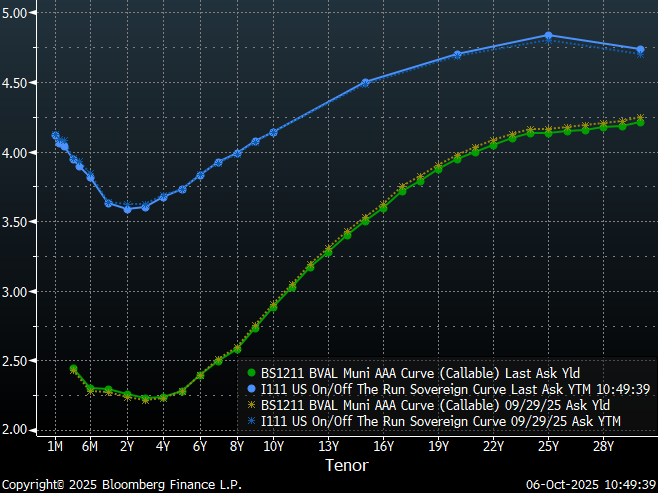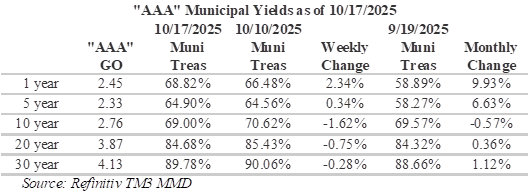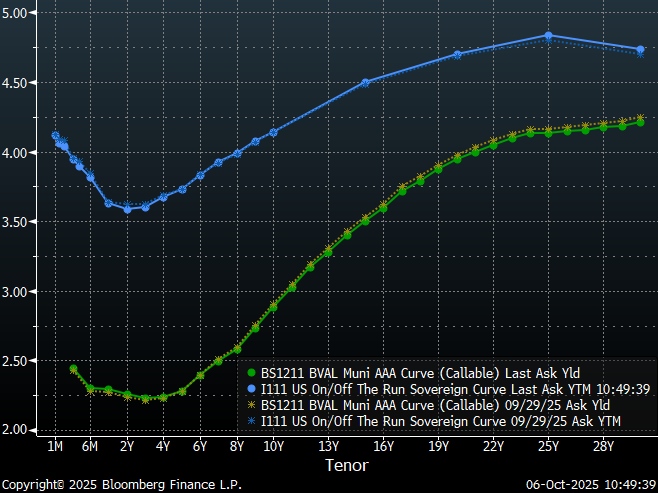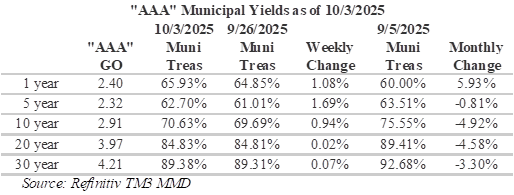Our team of market analysts have a singular mission: to help you make better investment decisions. Read the latest market commentary.
Continue reading2025 Charter School USA’s National Education Institute Conference
HJ Sims is proud to be attending and sponsoring at the 2025 Charter School USA’s National Education Institute Conference.
Attending: Richard Harmon
2025 Smith’s High Yield Municipal Bond Conference
HJ Sims is proud to be attending and speaking at the 2025 Smith’s High Yield Municipal Bond Conference.
Aaron Rulnick, Managing Principal, will be presenting on the topic below:
Presentation Title:
Topic: Golden Years in a Golden Age
Date and Time: October 28, 2025 at 10:45
2025 EngAGE Conference
Curve Commentary: October 20, 2025
Overview
The shutdown, which is now the third longest government shutdown in U.S. history, continues to populate headlines. In addition, markets are operating without the usual government sourced economic data from the Bureau of Labor Statistics and the Bureau of Economic Analysis. Absent this data, the markets have been looking to private sources and anecdotal data from businesses for guidance. However, data from these sources is less than optimal and is typically not as broad or representative of the economy as government data sets. Due to the weakening job market and a lack of updated government data to demonstrate otherwise, the markets are operating under the assumption the Fed will make another quarter of a point cut at its meeting next week. Last week, Fed chair Jerome Powell indicated that economic concerns of the Fed had not changed during the data blackout. The Fed funds futures market is currently indicating an almost certain 94.6% chance of a 25bps rate cut at the Fed’s October 29 meeting and an additional 25bps cut in December.
Over the past week, Treasury and municipal markets have been largely unphased by the shutdown or the regional bank distress with yields experiencing minimal change on the long end of the yield curve. Treasury yields rallied about 4.55 bps versus 5.5 bps for munis. On the more policy sensitive short tenors under 2-years, yields differed with Treasuries selling-off a little over 5 bps and munis rallying around 3 bps. Treasuries have lately been responding to haven buying, trade tensions and anxiety related to regional bank credit exposure.

Insights and Strategy
Slopes along the municipal yield curve are currently steepest around the 17-year tenor, with over 61 bps in slope from 13 to 18-years. This is a significant change from earlier this month, when the steepest slopes were around the 10-year tenor. This shift increases the reward to investors for extending from the 10-year range to the 15-20-year range. Although the municipal yield curve continues to reward duration, the long-end has become very flat with steadily declining slopes from 20 to 30-years and only a basis point or so per year past 25-years. However, as a result of this flat tail, municipal bond investors can buy maturities under 20-years that yield over 92% of the 30-year curve.

The muni/Treasury ratio is a widely watched measure that provides a sense of how tax-exempt munis fare against taxable fixed-income options. Crossover investors, which seek to identify the best opportunities in the fixed income universe on an after-tax basis, closely follow this ratio. Over the past month, the biggest moves have been around the 10-year maturity where ratios have cheapened close to 10% with ratios now approaching 70%. Although this part of the curve has become significantly more appealing from a relative value perspective, ratios are still rich from a historical perspective with a 10-year mean for this part of the curve at 94.59%. For investors seeking to maximize curve positioning with relative value, the 18-year part of the municipal yield curve currently provides almost 90% of the 30-year maturity and over 80% of equivalent Treasury yields.

Month-to-date, lower-coupon 4s have outperformed in October, benefiting from their longer duration and greater sensitivity to the rally in rates. Against the backdrop of falling yields, lower coupon bonds have recently experienced stronger price appreciation versus higher coupon bonds, which are less responsive in a declining rate environment. However, this week we are anticipating a full municipal calendar with over $15 billion in new issues. Overall, with the potential for Treasury volatility amid the government shutdown and heavy supply from the municipal calendar, continued outperformance from lower coupon bonds may prove challenging this week.
Herbert J. Sims & Co. Inc. is a SEC registered broker-dealer, a member of FINRA, SIPC. The information contained herein has been prepared based upon publicly available sources believed to be reliable; however, HJ Sims does not warrant its completeness or accuracy and no independent verification has been made as to its accuracy or completeness. The information contained has been prepared and is distributed solely for informational purposes and is not a solicitation or an offer to buy or sell any security or instrument or to participate in any trading or investment strategy, and is subject to change without notice. All investments include risks. Nothing in this message or report constitutes or should be construed to be accounting, tax, investment or legal advice.
Market Commentary: Shady Pines
Our team of market analysts have a singular mission: to help you make better investment decisions. Read the latest market commentary.
Continue reading2025 RiverSpring 108th Anniversary Fall Gala
HJ Sims is proud to be attending the 2025 RiverSpring 108th Anniversary Fall Gala.
Attendees: Andrew Nesi
2025 APSRC’s Annual Fall Conference
HJ Sims is proud to be attending the 2025 APSRC’s Annual Fall Conference.
Attending: Robert Nickell, Akshai Patel
BridgePrep Academy Case Study (July 2025)

Partnered Right®
- BridgePrep Academy (“BPA”) currently operates 20 schools; the Series 2025 Bonds included nine of BPA’s schools
- The nine schools included in the 2025 financing serve approximately 6,200 K-12 students, with enrollment projected to exceed 7,000 by 2030
- HJ Sims collaborated with SMART Management (BPA’s education management organization) to optimize the financing around its existing operations
Structured Right®
- Proceeds of the Series 2025 Bonds were used to 1) fund the acquisition of multiple charter school facilities, 2) fund various capital expenditures, 3) payoff an existing bank loan, 4) fund a debt service reserve fund, and 5) pay bond issuance costs
- The Series 2025 Bonds have a 40-year maturity and were structured with five tax-exempt term maturities and one taxable term maturity
- The Series 2025 Bonds are callable in seven years @ 102%, with the call premium declining to par in nine years
Executed Right®
- HJ Sims successfully priced the Series 2025 Bonds despite a volatile market environment
- The underwriting syndicate secured $486.5 million in orders, a 2.4x oversubscription
- Individual maturities were oversubscribed 1.4 – 5.7x
- 16 institutional investors submitted orders for the Series 2025 Bonds
Financed Right®
- HJ Sims delivered a 40-year fixed rate “Ba1” rated financing for BPA at a true interest cost of 6.35%
- The Series 2025 Bonds enables BridgePrep Academy to continue to expand its capacity to serve students in Florida
EPISCOPAL RETIREMENT SERVICES Case Study (September 2025)
Fixed Rate Bonds Placed with Single
Investor for First Phase of Critical
Repositioning Project
Market Commentary: Standing By
Our team of market analysts have a singular mission: to help you make better investment decisions. Read the latest market commentary.
Continue readingTHE JEWISH ASSOCIATION ON AGING Case Study (May 2025)
Fixed Rate Bonds Placed with Single
Investor for First Phase of Critical
Repositioning Project
2025 LeadingAge CT Annual Meeting
2025 LeadingAge MA Annual Meeting of the Membership
HJ Sims is proud to be attending the 2025 LeadingAge MA Annual Meeting of the Membership Conference.
Attendees: Andrew Nesi
Curve Commentary: October 6, 2025
Overview
Although the U.S. government shutdown last week, Treasury and municipal markets were largely undaunted with yields experiencing only minimal change. However, the shutdown has resulted in the Bureau of Labor Statistics postponing its Employment Situation report, which is ordinarily delivered on the first Friday of the month, to report on employment levels and unemployment. Despite the lack of data, Treasury yields only moved down by about 4 bps on the short-end and up by about 5 basis points on the long-end with the 5-year tenor essentially unchanged. Muni yields moved in almost the opposite direction, with short yields climbing 2 basis points and long yields falling about 3.5 basis points and, like Treasuries, 5-year yields were essentially unchanged. Furthermore, the Fed funds futures market is currently indicating an almost certain 94.6% chance of a 25bps rate cut at the Fed’s October 29 meeting.

Overall, the Treasury curve is about 9 bps steeper over this past week and the muni curve is about 5.5 bps flatter. Slopes along the municipal yield curve are steepest around the 10-year tenor, with over 50 bps in slope from 8 to 12-years. Although the municipal yield curve continues to reward duration, the long-end has become very flat with steadily declining slopes from 15 to 30-years and only a basis point per year past 25-years. As a result of the flat tail, municipal bond investors can buy maturities under 20-years that yield over 90% of the 30-year curve.
Insights and Strategy
Muni/Treasury ratios, which provide a sense of how tax-exempt munis fare against taxable fixed-income options, have generally cheapened over the past week. Crossover investors, which seek to identify the best opportunities in the fixed income universe on an after-tax basis, closely follow this ratio. While shorter ratios have cheapened the most, they remain only narrowly appealing even to individual investors in the top tax brackets. The 10-year historical mean for the 5-year tenor is 74.71% versus 62.7% today. Ratios on the longer end of the curve continue to reward investors for extending duration with 30-year ratios approaching 90%. Although ratios in this part of the curve are meaningfully richer than they were a month ago, they continue to provide compelling value. For investors seeking to maximize curve positioning with relative value, the 12 to 18-year part of the municipal yield curve provides as much as 90% of the 30-year maturity and over 80% of equivalent Treasury yields.

This week, municipal issuers are expected to sell more $12.9 billion in new issues with year-to-date issuance levels eclipsing $436 billion, which is 13.5% more than had been issued last year at this time. Transportation issues dominate the calendar this week with the Texas Transportation Corp. selling $1.8 billion, the State of Maryland Department of Transportation selling $842.7 million and the North Texas Tollway offering 627.2 million. This supply will likely be met with strong demand with $11.8 billion in municipal bonds expected to mature in the next 30-days, $5 billion in calls announced over the next 30-days and LSEG Lipper Global Fund Flows reporting weekly inflows of $1.1 billion last week.
Herbert J. Sims & Co. Inc. is a SEC registered broker-dealer, a member of FINRA, SIPC. The information contained herein has been prepared based upon publicly available sources believed to be reliable; however, HJ Sims does not warrant its completeness or accuracy and no independent verification has been made as to its accuracy or completeness. The information contained has been prepared and is distributed solely for informational purposes and is not a solicitation or an offer to buy or sell any security or instrument or to participate in any trading or investment strategy, and is subject to change without notice. All investments include risks. Nothing in this message or report constitutes or should be construed to be accounting, tax, investment or legal advice.
Market Commentary: Showdown Shutdown
Our team of market analysts have a singular mission: to help you make better investment decisions. Read the latest market commentary.
Continue readingThe Legacy Senior Communities, Inc. Case Study (July 2025)
HJ Sims successfully structured and executed a $72.54 million refinancing of existing bank debt for The Legacy Senior Communities, providing stable, fixed-rate debt service for its Legacy at Midtown Park community through maturity.
Continue readingCurve Commentary: September 29, 2025
Overview
With government funding set to expire Tuesday, the shadow of a potential government shutdown continues to loom over the bond market bringing yields down across the Treasury curve. In addition, the shutdown threatens to delay the release of key economic data, including Friday’s nonfarm payroll employment data and unemployment rate from the Bureau of Labor Statistics. This data is critical to current rate forecasts as weakening employment data was an influential factor in the Fed’s decision to cut rates earlier this month. The Fed has recently commented that labor demand, and the recent pace of job creation, appear to be running below the “breakeven” rate needed to maintain current unemployment levels. The Fed funds futures market is currently indicating an 88.7% chance of a 25bps rate cut at its October 29 meeting.

Last week, Treasuries were largely unchanged with the threat of a government shutdown drawing a haven bid while the front-end of the muni curve experienced the majority of the movement. Muni yields in this part of the curve have become quite rich with muni/Treasury ratios in the 50’s for one to five years. At these levels, yields are only narrowly appealing even to individual investors in the top tax brackets. Following last week’s moves, ratios popped-up to the low to mid-60’s on the front-end of the muni curve with significant pressure from institutional investors positioning portfolios ahead of the quarter-end.

Insights and Strategy
Although the muni curve remains steeper than the Treasury curve, last week’s sell-off resulted in considerable flattening for munis maturing within 10-years. Over the past 2-months we have experienced significant compression of spread relationships in this portion of the curve. However, it is notable that the steepest portion of the municipal yield curve is currently the 9 to 11-year stretch with a slope of 46 bps. Although the municipal yield curve remains positively sloped, investors should exercise caution to manage duration risk by buying bonds where the yield curve has sufficient slope to reward risk.

Nevertheless, long munis continue to provide compelling relative value with 20-year munis yielding almost 85% of Treasuries and 30-year munis yielding almost 90% of Treasuries. Even the 12-year tenor, which is less than half of the 30-year curve, is yielding 75% of the 30-year maturity, making this an appealing place to position new purchases. Past 20-years, the slope tapers significantly to just a basis point or two per year. For investors with longer mandates, I would consider buying shorter in the 12 to 17-year range and wait to see if the long-end steepens before extending.
Herbert J. Sims & Co. Inc. is a SEC registered broker-dealer, a member of FINRA, SIPC. The information contained herein has been prepared based upon publicly available sources believed to be reliable; however, HJ Sims does not warrant its completeness or accuracy and no independent verification has been made as to its accuracy or completeness. The information contained has been prepared and is distributed solely for informational purposes and is not a solicitation or an offer to buy or sell any security or instrument or to participate in any trading or investment strategy, and is subject to change without notice. All investments include risks. Nothing in this message or report constitutes or should be construed to be accounting, tax, investment or legal advice.
Market Commentary: Falling
Our team of market analysts have a singular mission: to help you make better investment decisions. Read the latest market commentary.
Continue reading2025 Florida Charter School Conference + School Choice Summit
HJ Sims is proud to be attending the 2025 Florida Charter School Conference & School Choice Summit.
Attending: Robert Nickell, Richard Harmon, Akshai Patel, John Solarczyk








